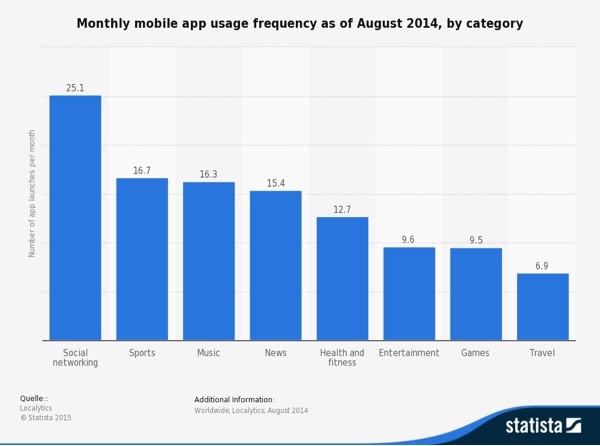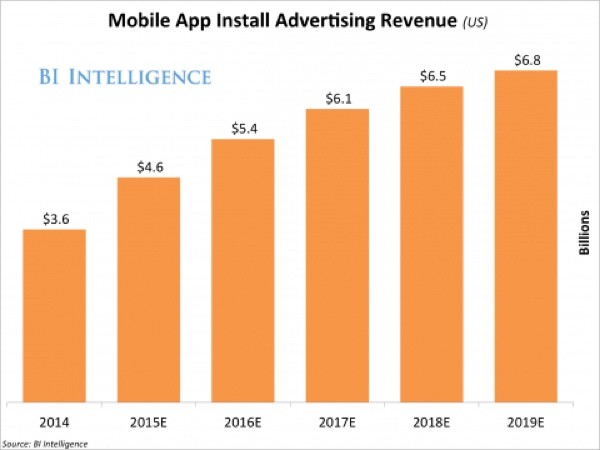Mobile app revenues are booming, but for how long?
It’s a shame that more than 90% of apps are languishing in a fairly lonely state, with small numbers of downloads for the vast majority.
However, iOS app revenues topped Hollywood movie revenues in 2014, driving app developers to spend large sums of money to drive app installations. Is this shift in ad spending permanent or just a temporary measure until mobile search and the entire mobile web experience improves?
It’s a shame that more than 90% of apps are languishing in a fairly lonely state, with small numbers of downloads for the vast majority.
However, iOS app revenues topped Hollywood movie revenues in 2014, driving app developers to spend large sums of money to drive app installations. Is this shift in ad spending permanent or just a temporary measure until mobile search and the entire mobile web experience improves?
The app installation economy
It has been estimated recently that the percentage of people who open an app more than once (in any given three month period) ended last year at just 12%. However, other reports seem to indicate that engagement with apps is high when compared with the mobile web. Unfortunately, the number of apps that do enjoy high engagement with users are few and far between – those such as Facebook and Twitter are amongst the lucky few that people tend to use on a daily basis.
MUST READ: Mobile video advertising has a huge future
This chart from Statista.com indicates how frequently different categories of apps are used on mobile devices – social network, unsurprisingly, is one of the most-used categories of mobile apps.
 SOURCE: Statista.com.
SOURCE: Statista.com.
Many of the other apps we have on our smartphones languish in an underused state, just begging to be used. Google has indicated that 52% of apps on the average smartphone (in the US) have not been used in the last month.
Data from BI Intelligence finds that US mobile app-install ad revenue will top $4.6 billion this year and grow to $6.8 billion by the end of 2019, increasing by a compound annual growth rate of 14% from 2014. BI Intelligence states that the app installation revenue makes up 30% of all mobile ad spending, with an average click through rate (CTR) of just under 1% in the first quarter of 2014, in contrast with an average CTR of 0.24% for every Facebook ad type across desktop and mobile. That indicates a business with considerable room for growth, however it’s not exactly the type of growth that has been typical of mobile in the past.
$2.2 billion dollars of growth in app-install ad revenues is a sizeable sum, however 14% compound annual growth is surprisingly low considering the explosion in mobile apps. A large proportion of the growth in mobile apps comes from non-game related apps, but at some point, as the Internet and high-speed networks catch up in terms of the user experience and functionality, we may return to the situation that we face with desktop…
It has been estimated recently that the percentage of people who open an app more than once (in any given three month period) ended last year at just 12%. However, other reports seem to indicate that engagement with apps is high when compared with the mobile web. Unfortunately, the number of apps that do enjoy high engagement with users are few and far between – those such as Facebook and Twitter are amongst the lucky few that people tend to use on a daily basis.
MUST READ: Mobile video advertising has a huge future
This chart from Statista.com indicates how frequently different categories of apps are used on mobile devices – social network, unsurprisingly, is one of the most-used categories of mobile apps.

SOURCE: Statista.com.
Many of the other apps we have on our smartphones languish in an underused state, just begging to be used. Google has indicated that 52% of apps on the average smartphone (in the US) have not been used in the last month.
Data from BI Intelligence finds that US mobile app-install ad revenue will top $4.6 billion this year and grow to $6.8 billion by the end of 2019, increasing by a compound annual growth rate of 14% from 2014. BI Intelligence states that the app installation revenue makes up 30% of all mobile ad spending, with an average click through rate (CTR) of just under 1% in the first quarter of 2014, in contrast with an average CTR of 0.24% for every Facebook ad type across desktop and mobile. That indicates a business with considerable room for growth, however it’s not exactly the type of growth that has been typical of mobile in the past.
$2.2 billion dollars of growth in app-install ad revenues is a sizeable sum, however 14% compound annual growth is surprisingly low considering the explosion in mobile apps. A large proportion of the growth in mobile apps comes from non-game related apps, but at some point, as the Internet and high-speed networks catch up in terms of the user experience and functionality, we may return to the situation that we face with desktop…
So long, isolated apps
Today, most apps are fairly standalone entities and largely behave as isolated programs.
A former Google employee, Paul Adams (who now works at Intercom), believes that:
The idea of having a screen full of icons, representing independent apps, that need to be opened to experience them, is making less and less sense. The idea that these apps sit in the background, pushing content into a central experience, is making more and more sense. That central experience may be something that looks like a notification centre today, or something similar to Google Now, or something entirely new.
If that notion comes to pass, the app becomes less important. In its place are contextually relevant notifications and messages presented to the user at the right time and place.
Adams says that we’re already seeing this change as increasingly, “notifications are the app” – and they allow users to interact without even needing to open one.
In Apple’s iOS 8, notifications have indeed become much more interactive (and useful – for example, you can reply to messages or interact with emails right from the notification itself.
As the concept develops, notifications may be able to provide a fuller experience with more independent actions – such as commenting on a Facebook post, or re-tweeting a tweet, even things like purchasing music or tickets. In this scenario, the mobile operating systems become more important than ever. Apps start to take a back seat, and the data they use that sits on some remote server becomes even more key to the overall user experience.
One of the predictions for mobile apps is that “Isolated apps are out, ‘micro-moments’ are in”, and that the market is shifting away from apps, and toward more contextually relevant micro-moments, delivered across families of devices, that are personalized to anticipate unique customer needs. Indeed, Forrester analysts Jeffrey Hammond and Michael Facemire believe that standalone apps will lose their lustre in 2015 (as well as other predictions that will affect mobile development).
For now, the mobile app in its current form seems here to stay at least for a while yet. Revenues are still impressive and developers are spending huge sums on advertising to drive app installs. Unfortunately, many of those apps are rarely opened. It remains to be seen how mobile apps will evolve going forward over the next few years, and how developers can promote and drive their apps to stand out from the pack.
Today, most apps are fairly standalone entities and largely behave as isolated programs.
A former Google employee, Paul Adams (who now works at Intercom), believes that:
The idea of having a screen full of icons, representing independent apps, that need to be opened to experience them, is making less and less sense. The idea that these apps sit in the background, pushing content into a central experience, is making more and more sense. That central experience may be something that looks like a notification centre today, or something similar to Google Now, or something entirely new.
If that notion comes to pass, the app becomes less important. In its place are contextually relevant notifications and messages presented to the user at the right time and place.
Adams says that we’re already seeing this change as increasingly, “notifications are the app” – and they allow users to interact without even needing to open one.
In Apple’s iOS 8, notifications have indeed become much more interactive (and useful – for example, you can reply to messages or interact with emails right from the notification itself.
As the concept develops, notifications may be able to provide a fuller experience with more independent actions – such as commenting on a Facebook post, or re-tweeting a tweet, even things like purchasing music or tickets. In this scenario, the mobile operating systems become more important than ever. Apps start to take a back seat, and the data they use that sits on some remote server becomes even more key to the overall user experience.
One of the predictions for mobile apps is that “Isolated apps are out, ‘micro-moments’ are in”, and that the market is shifting away from apps, and toward more contextually relevant micro-moments, delivered across families of devices, that are personalized to anticipate unique customer needs. Indeed, Forrester analysts Jeffrey Hammond and Michael Facemire believe that standalone apps will lose their lustre in 2015 (as well as other predictions that will affect mobile development).
For now, the mobile app in its current form seems here to stay at least for a while yet. Revenues are still impressive and developers are spending huge sums on advertising to drive app installs. Unfortunately, many of those apps are rarely opened. It remains to be seen how mobile apps will evolve going forward over the next few years, and how developers can promote and drive their apps to stand out from the pack.

